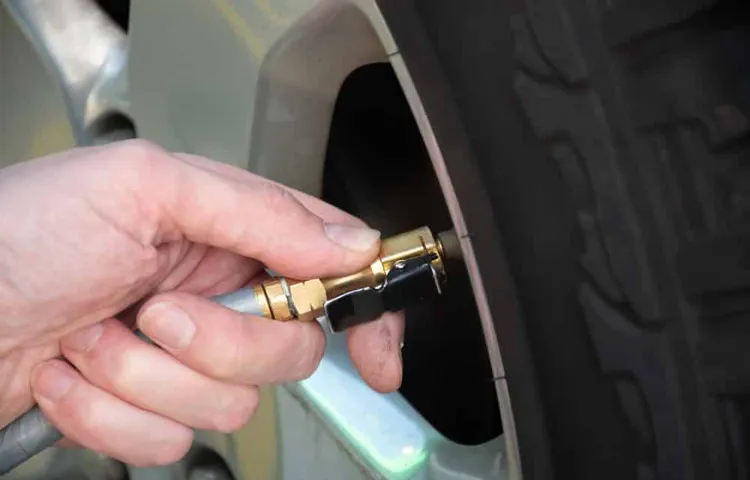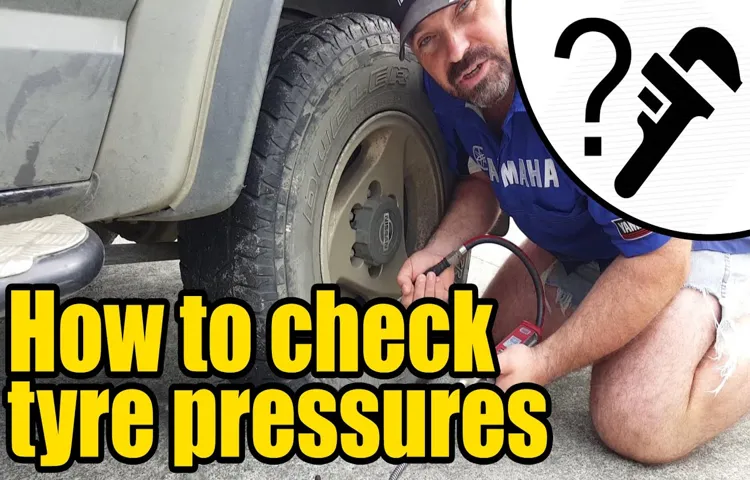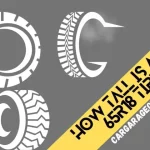Have you ever found yourself at a gas station, staring blankly at the air pump machine, unsure of how to fill your tires to the proper pressure? You’re not alone. Many people feel intimidated by the process, but the truth is, it’s actually quite simple. In this blog post, we’ll go over the steps to fill your tire pressure at a gas station, so you can avoid any potential mishaps on the road.
Think of your tires as the shoes for your car. Just like your shoes, they need to fit properly to ensure comfort and stability. The same applies to your vehicle’s tires.
Proper tire pressure ensures that your car handles well and performs efficiently. So, let’s get started! First, you’ll need to check your tire pressure using a tire gauge. You can purchase one at any auto parts store or even at the gas station, usually near the air pump machine.
Next, locate the valve stem on your tire and remove the valve cap. Then, press the tire gauge onto the valve stem to get a reading of the current pressure. Once you’ve determined the tire’s pressure, compare it to the recommended pressure listed on the placard located on the driver’s side door jamb or in your vehicle’s manual.
If the tire pressure is too high or too low, use the air pump at the gas station to adjust the pressure by adding or releasing air. Simply attach the air hose to the valve stem and add air until it reaches the recommended pressure. If you add too much air, simply press the gauge onto the valve stem to release air until you reach the correct pressure.
In conclusion, filling tire pressure at a gas station is a straightforward process that will ensure your vehicle runs safely and efficiently. Remember to check the tire pressure regularly and fill as necessary. With this knowledge, you are now ready to tackle the gas station air pump with ease!
Table of Contents
Gather Equipment
If you need to fill your tire pressure at a gas station, the first thing you’ll need to do is gather the necessary equipment. You should have a tire pressure gauge and a source of air readily available. If you don’t have your own tire pressure gauge, most gas stations have one available for customers to use.
You’ll also need to ensure that the air pump at the gas station has a gauge on it to accurately measure the air pressure you’re adding to your tires. It’s important to note that not all gas stations have air pumps available for customer use, so it’s a good idea to call ahead to ensure the station you plan on visiting has what you need. Once you have your equipment, you’re ready to start the process of filling your tires with air.
Insert the gauge into the tire valve and take a reading. Then, add or release air as needed until you reach the recommended pressure level, which can be found in your vehicle owner’s manual or on a sticker located inside your driver’s side door. By carefully following these steps, you can ensure that your tires are properly inflated and ready for the road ahead.
Check Tire Pressure Gauge
When it comes to checking your tire pressure, having the right equipment is key. One of the most important tools you’ll need is a tire pressure gauge. This small device is essential for accurately measuring the pressure in your tires and ensuring they are properly inflated.
To get started, you’ll need to gather a few things. First, locate your tire pressure gauge (if you don’t have one, you can purchase one at any auto parts store). Next, make sure you have a tire pressure chart or know the recommended tire pressure for your vehicle.
Finally, you’ll need a source of air, such as an air compressor or gas station air pump. With these items in hand, you’re ready to start checking your tire pressure and maintaining your vehicle’s safety and performance. So, take the time to check your tire pressure regularly and avoid unnecessary wear and tear on your tires.
Your wallet – and your safety – will thank you!

Locate Air Pump at Gas Station
If you’re on the road and suddenly realize that your car’s tires need some air, finding the air pump at a gas station can sometimes be a challenge. But don’t worry, it’s easier than you think! First of all, make sure you have the necessary equipment with you, such as a tire pressure gauge and some quarters. Once you’re at the gas station, take your time to locate the air pump.
They are typically located near the gas station building, and they are sometimes marked with a sign. If you’re not sure, don’t hesitate to ask the gas station attendant for help. Once you’ve found the air pump, make sure to park your car near it, and use your quarters to activate the machine.
Follow the instructions on the air pump and use your tire pressure gauge to check the pressure of your tires. Keep in mind that overinflating your tires can be just as dangerous for your car as underinflating them. With these simple steps, you can locate the air pump at a gas station and keep your tires properly inflated.
Fill Tire with Correct Pressure
Are you wondering how to fill tire pressure at a gas station? Don’t worry, it’s a simple process that can prevent serious accidents on the road. First, refer to your vehicle’s owner’s manual to find the recommended tire pressure. Once you have this information, locate the air pump at the gas station.
Remove the valve cap and attach the air hose to the valve stem, ensuring a secure connection. Use the machine’s gauge to monitor the pressure level and add air until you reach the recommended pressure. Check the pressure again with your own gauge to ensure accuracy.
Finally, replace the valve cap and repeat the process for the remaining tires. Remember, properly inflated tires can improve fuel efficiency and prolong tire lifespan, so it’s important to check regularly and fill as needed.
Remove Valve Cap
When checking the air pressure in your tires, it’s important not just to know what the correct pressure is, but also to know how to fill your tires properly. One important step in filling your tires with the correct pressure is to remove the valve cap. This small cap covers the valve stem that allows air to flow into and out of your tire.
When you remove the cap, make sure to keep it somewhere safe so that you don’t lose it. Once the valve cap is removed, you can attach your tire gauge or air pump to properly fill your tire to the correct pressure. By taking the time to remove the valve cap and fill your tires to the correct pressure, you’ll help to ensure that your car is safe to drive and that your tires last as long as possible.
Attach Air Hose to Valve Stem
When it comes to filling your tires with the correct pressure, attaching an air hose to the valve stem is crucial. This may seem like a straightforward task, but there are a few things to keep in mind to ensure you do it correctly. First, make sure the valve stem is clean and free of debris.
Then, firmly attach the air hose to the stem, making sure it is straight and lined up properly. Once attached, turn on the air compressor and allow the tire to fill with air. Keep an eye on the pressure gauge and adjust the air flow as needed to reach the desired pressure.
It’s important to check the pressure often since over-inflating can be just as dangerous as under-inflating. By taking the time to properly attach the air hose and fill your tires, you’ll not only increase safety while driving but also extend the life of your tires.
Add Air Until Desired Pressure Is Reached
When it comes to maintaining proper tire pressure, adding air until the desired pressure is reached is crucial. Underinflated tires can be dangerous and cause handling and braking issues while overinflated tires can impact the ride comfort and fuel efficiency. To fill a tire with the correct pressure, start by checking the recommended pressure level given in the owner’s manual or on the driver’s door jamb.
Then, remove the valve stem cap and attach the air hose to it, making sure it fits tightly. Using a tire pressure gauge, check the tire pressure and add air until the desired level is reached. It is important not to overinflate the tire, as this can cause damage.
After reaching the appropriate pressure level, check the tire pressure again to confirm it is accurate, and then replace the valve stem cap. Regularly checking tire pressure can extend the lifespan of your tires and ultimately contribute to a safer and more fuel-efficient driving experience.
Check Tire Pressure Again
Are you wondering how to fill tire pressure at a gas station? It’s a simple task that you can easily do yourself. First, locate the air pump at the gas station. Then, unscrew the valve stem cap on your tire and attach the air hose to the stem.
Check your tire pressure using a tire pressure gauge to ensure you fill it to the correct psi. Fill your tire with air and listen for the sound of air escaping, indicating your tire is properly inflated. Remember to check the tire pressure again after filling and adjust if necessary.
Proper tire pressure is crucial for safety while driving, improving handling, fuel efficiency, and the lifespan of your tires. So next time you’re at a gas station, take a few minutes to check and fill your tire pressure for a smoother ride.
Use Tire Pressure Gauge to Confirm Pressure Level
Checking your tire pressure once is not enough to ensure safe and efficient driving. After filling your tires with air, it is important to use a tire pressure gauge to confirm the pressure level. Sometimes, gauges at gas stations or air pumps can be inaccurate, and relying on them can lead to over-inflation or under-inflation of your tires.
By using a tire pressure gauge, you can accurately measure the pressure and ensure that it aligns with the recommended level for your vehicle. It’s a quick and easy step that can make all the difference in your driving experience. Remember, proper tire pressure not only improves safety, but it can also save you money on fuel costs.
So, take the extra minute to use a tire pressure gauge and confirm your tire pressure level, your wallet and your safety will thank you.
Adjust If Necessary
After checking your tire pressure, it’s important to take any necessary adjustments. If the pressure is lower or higher than recommended, take the time to adjust it accordingly. This can greatly impact your car’s performance and safety, as well as the lifespan of your tires.
If your car’s handling feels off, it’s possible that the tire pressure is the culprit. Even a few PSI underinflated or overinflated can make a noticeable difference. Don’t hesitate to check your tire pressure several times until everything is just right.
It’s a simple task that can make a big difference in the long run. Plus, it can save you from the inconvenience of a flat tire or an unexpected blowout on the road. Ultimately, taking the time to properly adjust your tire pressure can make for a smoother, safer driving experience.
Conclusion with Safety Tips
In conclusion, filling your tire pressure at a gas station doesn’t have to be a daunting task. Simply locate the correct tire pressure for your vehicle, grab some quarters, and channel your inner air-champion. And remember, a well-inflated tire is a happy tire – and a happy tire means a happy you!”
FAQs
What is the correct tire pressure for my car and where can I find this information?
The recommended tire pressure for your car can usually be found in your owner’s manual or on a sticker located on the driver’s side door jamb. It is important to stay within the recommended range to ensure proper handling and fuel efficiency.
Can I rely on the tire pressure gauge at the gas station, or should I invest in my own gauge?
While gas station tire pressure gauges can be convenient, they may not always be accurate. We recommend investing in your own tire pressure gauge to ensure proper inflation levels for your tires.
What is the correct procedure for filling my tires with air at a gas station?
First, remove the valve cap on your tire and press the tire pressure gauge onto the valve stem to determine the current pressure. Add air if needed, using the gas station’s air hose, and re-check the pressure with the gauge. Replace the valve cap and repeat for the remaining tires.
Can I overfill my tires with too much air?
Yes, it is important not to overinflate your tires as it can lead to uneven wear and potentially cause a blowout. Always refer to your owner’s manual for the recommended tire pressure and use a gauge to ensure proper inflation.
How often should I check my tire pressure?
It is recommended to check your tire pressure at least once a month and before long trips. Changes in temperature can also affect tire pressure, so it’s a good idea to check after extreme heat or cold.
What are some signs that my tires may be underinflated?
Underinflated tires can cause poor handling, decreased fuel efficiency, and uneven wear. Signs to look out for include a visibly flat tire, a tire pressure warning light on your dashboard, and a feeling of the car pulling to one side.
Are there any risks to driving on underinflated tires?
Yes, driving on underinflated tires can be dangerous as it can lead to blowouts and loss of control on the road. It is important to check your tire pressure regularly to ensure your safety while driving.



